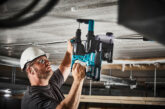
Vice President of Global Marketing and Business Development for Fulham Co. Russ Sharer explains how LED lighting systems can pave the way for further energy saving.
Buildings are going green, and electricians are under pressure to make the most of energy saving innovations without adding to costs.
Cutting energy costs is good for the planet and good for business, and with technological advances in illumination, LED lighting systems are the logical place to start to both save energy and control energy use.
Research shows that lighting and HVAC contribute to approximately 71% of the energy consumed in the average commercial building.
Power producers in the U.S. estimate that, on average, 39% of energy is used for lighting.
By replacing incandescent lighting with LED luminaires, building managers get an immediate lighting energy saving of 75% – retrofitting with LED lighting systems quickly pays for itself.
The second reason LEDs are proving popular is because intelligent LED drivers lay the foundation for smart building management systems.
Studies show that commercial buildings can save an additional 29% on energy use with building automation.

In order to truly cut a building’s electrical costs, you need to firstly monitor energy usage to identify where energy can be saved, and secondly, implement energy controls to manage energy use.
The latest intelligent LED drivers have the ability to monitor and control energy usage for lighting systems and more.
Start with Smart Lighting Controls
Since LEDs are actually microcontrollers, they already have embedded intelligence and can be programmed to customise light output.
For example, lighting characteristics can be adjusted for light intensity or colour temperature.
You can also program LEDs to report on energy consumption and heat generated. LEDs can also be programmed to report and manage power consumption.
To gain this benefit, however, you need some means of communication.
Monitoring power for each luminaire is impractical with a single central meter, so that means connecting all the LED luminaires with individual intelligence and one communication system.
Power over Ethernet (PoE) is one connectivity approach – with a PoE infrastructure, you can power LED lighting, access energy use data and issue lighting control commands.
In fact, since LEDs use DC power, PoE lets you eliminate the drivers needed to convert DC to AC power, giving you direct access to LED luminaires over a Category 5 Ethernet cable.
Unfortunately, PoE lighting is still in its infancy and mostly applicable for new construction; no one would rewire an entire building with 10Base-T for the sake of smart lighting.
A better option for existing buildings is to use wireless communications.
A number of luminaire vendors are embracing wireless standards such as Bluetooth mesh to create an interconnected lighting system.
The advantage of Bluetooth mesh is that it is an open standard, so any vendor can develop their own Bluetooth mesh system and it will be compatible with any other system.
Bluetooth mesh is also scalable, and its mesh topology has built-in failover for reliability.
Once you have a network of connected LED luminaires in place, you can monitor and manage energy and lighting from a single dashboard.
You can view individual luminaires, sections of the building, or assess the building as a whole.
Over time, you can get a very accurate portrait of power consumption, including when and where the most energy is used.
Light system monitoring can also reveal problem areas, such as power spikes. Real-time light power monitoring can show you whether you have clean power, or if the incoming power is higher or lower than 230V.
It can also reveal other issues as, for example, in India, power theft is a big problem and with real-time power monitoring, you can not only detect if there is a fluctuation in power but exactly where it’s originating.
Using LED Lighting for Building Management
Once you have two-way control communications in place, sensors used with smart LED drivers can provide key insights into other building conditions.
Lights are the most prevalent electrical device in any commercial building; there are more lights than power sockets.
That means sensors can be added to LED lighting anywhere in the building.
You don’t have to equip every luminaire with a sensor; it’s simple enough to create a blended infrastructure of smart and dumb LED drivers and monitor the building by region or circuit.
With sensors in place, you can monitor other building conditions, such as temperature or air quality.
HVAC is the second biggest consumer of building energy, so with the correct sensors and software integration, the smart lighting system can be used to control HVAC.
For example, motion detectors can be used to turn off lights and heat in unused rooms.
The same management system can be used to monitor fire, smoke, poor air quality, specific sounds, and other conditions. The system can also be programmed to trigger a fire alarm or alert security services.
Smart LED drivers provide the intelligence needed for the next generation of intelligent buildings.
Upgrading lighting systems with intelligent LED drivers paves the way for a future of connected building management with significantly reduced power usage.
For more information on Fulham Co., visit: www.fulham.com.









